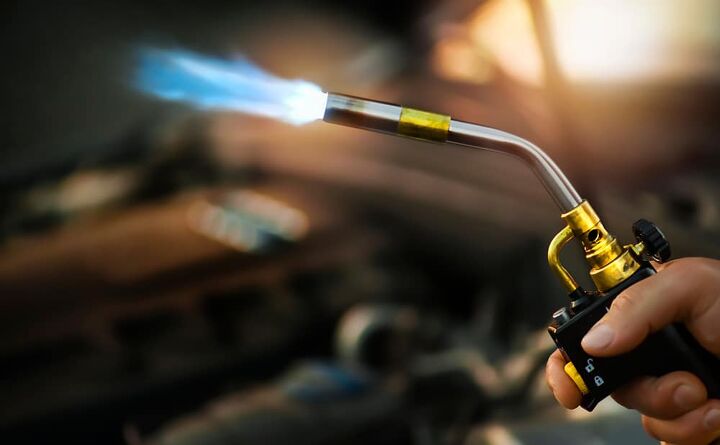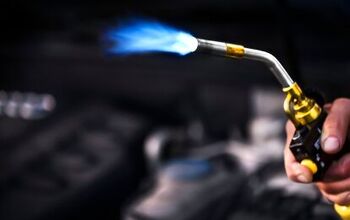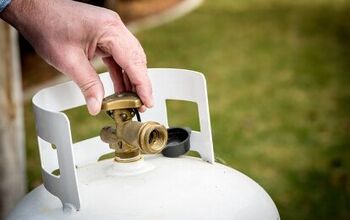How To Make A Propane Torch Burn Hotter (Find Out Now!)

The propane torch is a useful tool to have around the workshop. It can come in handy in many different situations. However, there are times when its power can feel lacking.
Sometimes, the flame produced by the propane torch may not be enough for the application you have in mind. You may be wondering if there’s something you can do to increase the intensity of the flame. The good news is that there is a simple way to make that kind of adjustment.
Start by unscrewing the torch’s nozzle and follow that by loosening the metallic insert you find using a socket wrench. After that, find a small drill bit that can fit into the cylindrical portion of the metallic insert. Secure the metallic insert inside a vise and hammer the drill bit into the cylinder until a small slug is dislodged.
Increasing the temperature output of your propane torch can make a real difference. Find out the different ways to maximize the potential of your propane torch by reading on.
How Hot Do Propane Torches Get?
Have you ever wondered how hot the flame coming from your propane torch is? Knowing the answer to that can help you decide if you need to give your torch a little boost in power. It’s worth noting that propane torches produce flames of varying temperatures.
On the low end, you have the propane-butane torches. Even when cranked up to their full capacity, the aforementioned torches still only reach about 2237 degrees Fahrenheit. That’s good enough for a decent amount of jobs, but it lags well behind the other options.
A step up from the propane-butane torches in terms of power are the propane-oxygen variants. The maximum temperature output for those torches is 3623 degrees Fahrenheit.
If you intend to use your propane torch for varied applications, the propane-oxygen option is clearly superior. You should be able to get more things done inside your workshop with the wide temperature range it offers. For those new to working in a workshop, the less potent option is a good pickup. You should be able to wield it safely while you get used to how a torch works.
How to Intensify the Flame Output of Your Propane Torch
If you’re dissatisfied with the flame output coming from your propane torch, you can do something about that. Follow the process detailed below to increase the power of your propane torch.
Step 1: Prepare the Tools
Completing this job requires using only a few items. Aside from the torch itself, you’ll want to prepare a hammer, your smallest drill bits, a socket wrench, and a vise.
Step 2: Unscrew the Torch Nozzle
Pick up your propane torch next and start to unscrew the top. Just give it a few twists and the torch should come off with no problem.
Step 3: Remove the Metallic Insert in the Nozzle
With the nozzle removed, flip it over and look inside. You should be able to spot a metallic insert lodged inside the nozzle. The insert looks almost like a screw.
Grab your socket wrench next and place it over the metallic insert. Continue working the socket wrench until you’re able to remove that small bit of metal.
Step 4: Find a Drill Bit Compatible with the Metallic Insert
Next, look through your drill bits and find one that will pair well with the metallic insert. What you’re looking for here is a drill bit that can fit into the cylindrical opening of that metallic bit. Keep trying out drill bits until you get the one that slides into the cylindrical opening easily.
Step 5: Hammer the Drill Bit into the Metallic Insert
You can now work on removing the piece that’s preventing your propane torch from producing a hotter flame. Slide the metallic insert into your vise and lock it in place. Make sure that the drill bit is already inside the insert before you place the piece into the vise.
Get your hammer now and start striking the drill bit. Keep hitting the drill bit until you see or hear a small bit of metal fall away from the insert. Using a needle instead of the drill bit is possible, but it’s harder to complete the job that way. That’s because the needle is more prone to breaking.
Step 6: Reassemble the Propane Torch
At this point, you can now put the torch back together. Place the metallic insert back into its original position inside the nozzle. Lock it in there by using your socket wrench.
Go ahead and reattach the nozzle to the fuel canister. Feel free to test out the propane torch now that it’s back in one piece. You should get a stronger flame after the adjustment you made.
How to Increase the Power of the Propane Torch Without Tinkering
Maybe you’re not completely comfortable tinkering with your propane torch. That’s perfectly understandable especially if you’re new to using that kind of tool. Still, does that mean that you won’t be able to get as much out of your propane torch as others?
You can still use your propane torch for high-temperature applications by working differently. The key is to focus the flame coming out of the torch. To focus the flame from the propane torch better, you’ll want to turn to the vise once more. Use the vise to hold whichever item needs more heat. Clamp the item down tightly to ensure it doesn’t move around.
Grab your propane torch next and train its flame on the item. Focus on a smaller spot first. Don’t spread the flame around because you’ll weaken it by doing so.
Melting a piece of metal or welding something will take more time using this method. Even so, you should consider trying it out if you’d rather not tinker around too much with your propane torch.
Shopping for a More Powerful Propane Torch
One more thing you can do if you’re unhappy with the flame output of your propane torch is to go shopping. You should know that you have options beyond the propane-oxygen and propane-butane torches.
Also on the market are items known as MAP torches. MAP stands for methylacetylene-propadiene propane. Some MAP torches produce flames as hot as 3720 degrees Fahrenheit. If that’s still not hot enough for you, look for the MAP torches that are combined with pure oxygen. When cranked all the way up, they can produce a flame that reaches a temperature of 5200 degrees.
Related Questions
Why Is the Propane Torch Producing a Yellow Flame?
A properly working propane torch is supposed to produce a blue flame. If what you’re getting from the propane torch appears yellow instead of blue, you have an issue on your hands.The likely explanation for why the flame coming from your torch appears yellow instead of blue is due to something lacking. The issue could be due to a lack of air or fuel. It’s an issue that tends to pop up often if you fail to position the torch properly while you’re using it.Check out the instructions for using your propane torch if you’re getting a yellow flame. See what you’re doing something wrong and correct that mistake.
Which Type of Propane Torch Should I Be Using?
The type of propane torch you should use depends on what kind of job you’re working on. The propane-oxygen torches are the multi-purpose torches. They are great for repairs and light soldering.The MAP torches are better suited for bigger soldering jobs. You can also use them for brazing, which is also known as the process of joining two metals together. The MAP torches combined with pure oxygen are best for cutting and melting metal quickly. Always be wary of their power whenever you use them.
How Do You Clean a Clogged Propane Torch?
Clogging is an issue that affects propane torches from time to time. Don’t worry though because it has an easy fix.Simply detach the nozzle from the torch and then boil the nozzle in some water. The debris should come loose while the nozzle boils. Now, just wait for the nozzle to dry completely before putting it back on the torch.
Related Guide

Gary Evans is passionate about home improvement. He loves finding out how to make improvements in the easiest, most practical, and most affordable ways. Upgrading his home kitchen is one of his ongoing hobbies. Gary is also a long-time content creator and enjoys spending his free time tending to his hydroponic vegetable garden.
More by Gary Evans



























